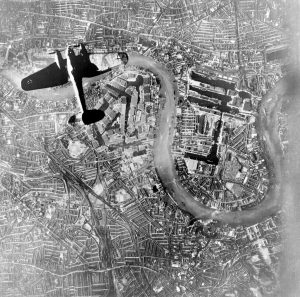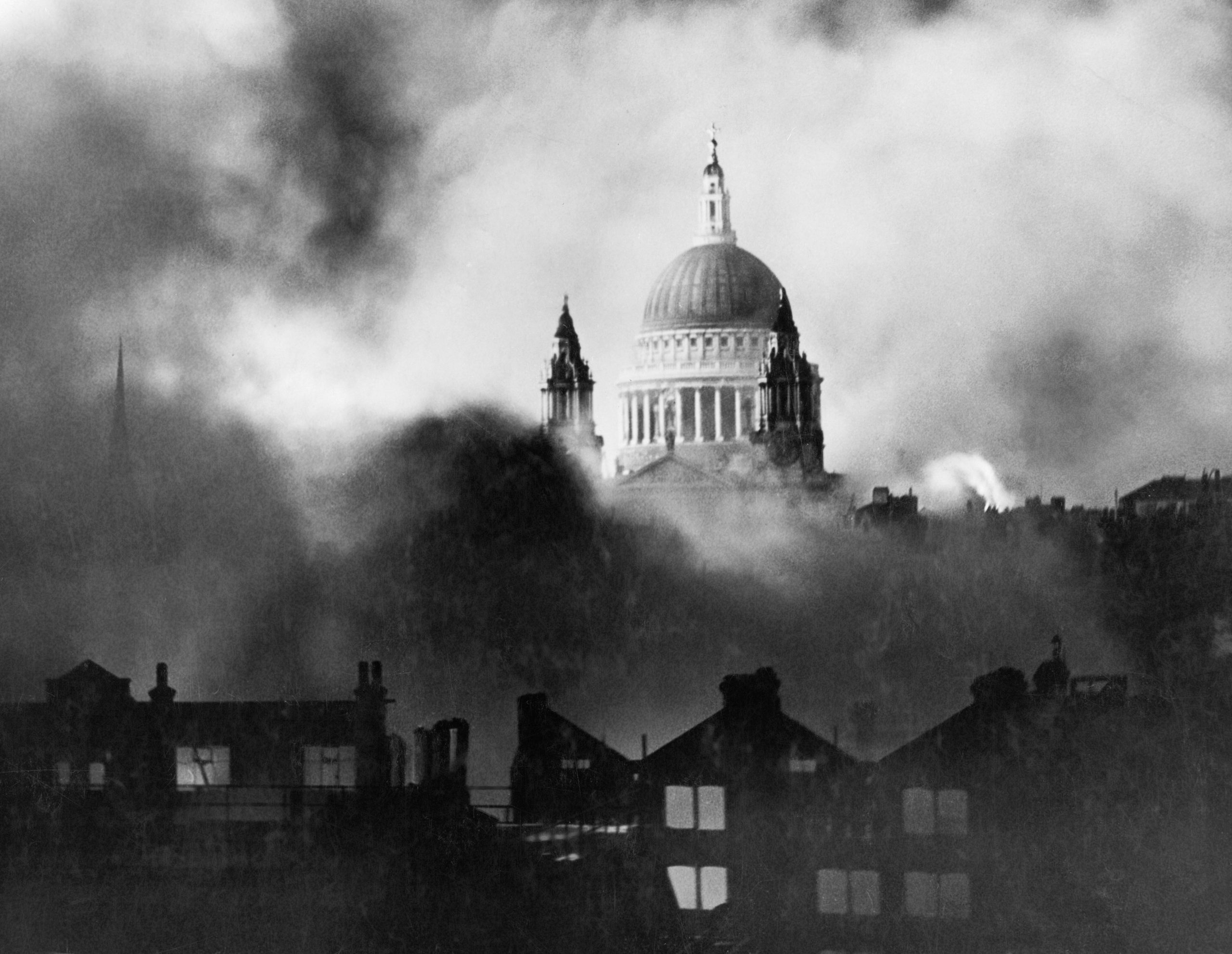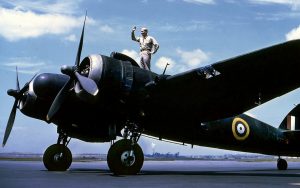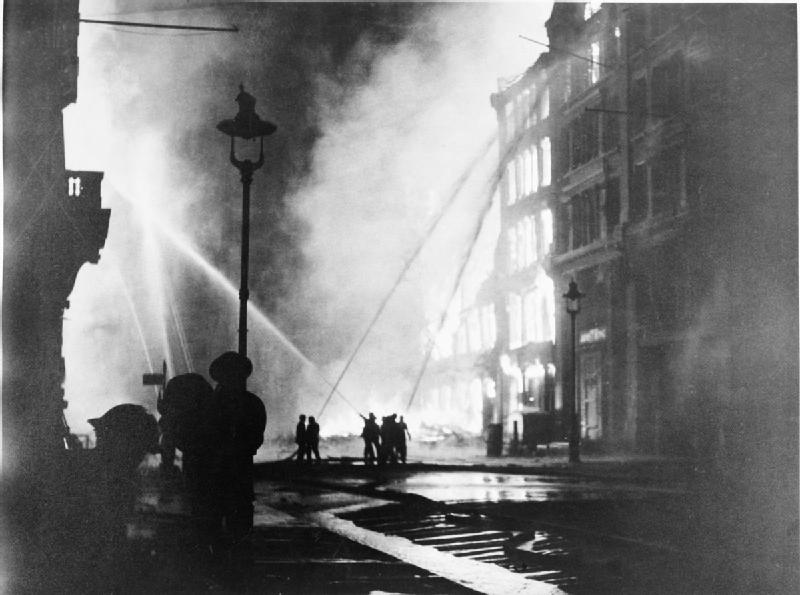The Blitz was a concentrated bombing campaign directed against the United Kingdom by the Luftwaffe, directed by Nazi High Command, between September 1940 and May 1941. Unlike the earlier Luftwaffe attacks during the summer of 1940 – the Battle of Britain – the assaults were not aimed at destroying air bases and other military targets, but at inflicting civilian casualties and devastating the infrastructure of the war effort and of daily life. Hitler’s goal was to destroy British civilian morale and force the UK government to surrender. The eight months of ferocious bombing caused the deaths of 43,500 people.
All British cities and large towns suffered from the bombings, especially those involved with the construction of ships and aircraft for the war effort. Clydebank, Liverpool and Southampton were badly hit, and some towns – such as Coventry in November 1940 – were almost completely destroyed. The bombers’ main focus, however, was London, the capital and centre of military operations. Over the eight months of the Blitz, more than 12,000 metric tons of bombs rained down on London.
***
7th September 1940 – Black Saturday
The Blitz is considered to have begun on 7th September 1940, ‘Black Saturday’. Around 350 Luftwaffe bombers dropped explosives on the East End of London, targeting the docks in particular. 450 people died.
Taking Shelter
As the bombings continued night after night through late 1940, Anderson shelters and Morrison shelters were issued to the public in their thousands. The government strongly discouraged Londoners from sheltering in the London Underground; it was feared that they would become a ‘race of troglodytes’. Almost immediately, however, people began to flock to the Tube for shelter, spending their nights sleeping on blankets on the low-level platforms. Powerless to stop the public from taking refuge in the Underground, the government quickly conceded and had toilet facilities and even beds installed in the Tube stations.
***
29th/30th December 1940 – The Second Great Fire of London
After an unofficial Christmas ceasefire, the bombers returned to London in force on the night of 29th December. Their target was the Square Mile, the financial district and old City of London. Thousands of incendiaries fell on the Old City, and soon fire was consuming banks, offices, churches and homes, just as it had in 1666. Firefighters, unable to draw enough water from the Thames at low tide, could do little to control it. A US war reporter based in the city cabled his office: “The second Great Fire of London has begun.”
Despite the devastation to the historic buildings around it, St Paul’s Cathedral survived with only minor damage. Winston Churchill, fearing loss of morale if the iconic domed cathedral were to be destroyed, ordered firefighters to protect St Paul’s at all costs. Despite restricted resources – many firefighters were equipped only with stirrup pumps – their efforts were successful. By morning, St Paul’s still stood, but other priceless 17th-Century churches had been burnt to ashes. Over 160 people were killed.
***
Night Fighters
In the early months of the Blitz, the public’s faith in British air defence was badly damaged. The fighter pilots of the RAF and Allied Countries, who had defended against German bombers so capably during the Battle of Britain, were now almost powerless to stop the bombers getting through. The Battle of Britain had been fought largely in daylight, as the Luftwaffe had needed all available light to hit precise targets such as individual British air bases; fighter pilots were able to see the bombers easily, and to attack them before they could reach their targets. During the Blitz, however, the bombers were aiming for much larger targets – cities and industrial areas – and so they made their raids at night. With no on-board radar equipment small enough to fit inside a Spitfire or Hurricane, the fighter pilots could not see the enemy bombers until the explosives had already fallen and the damage was done.
To address this problem, a new type of fighter plane was introduced: the heavy night fighter. Painted black for camouflage, these planes were much larger than a Spitfire, with room on board for a radar system to detect enemy planes. The most sophisticated of these new night fighters was the Bristol Beaufighter, later nicknamed the ‘Whispering Death’ because of its quiet engines and the high-pitched whistling sound it made at high speed.
Even the Beaufighter pilots struggled to spot the enemy, however, as the onboard radar equipment was in its infancy and still highly ineffective. While the Beaufighters flew blind, the bombs continued to fall on London in the early months of 1941.
***
11th January 1941 – the Bank Station bombing
From the earliest days of the Blitz, Londoners had taken shelter from night raids in the Underground. However, even the deepest subterranean stations could not offer complete protection. On the 11th January 1941, a bomb detonated in the booking office of Bank Station Underground. The blast destroyed the station, left a huge crater above ground and swept through the platforms where hundreds of people were sheltering. 111 died in the Bank Station bombing.
***
10th/11th May 1941 – the Hardest Night
The night of the 10th-11th May was the last and the most devastating night of the London Blitz. The moon was full, shining on the distinctive snaking line of the Thames. The river itself was at a low ebb, which would seriously hamper the London firefighters’ attempts to draw water. More than 500 Luftwaffe bombers took advantage of these ideal conditions to drop unprecedented numbers of explosives onto the capital.
The bombing lasted nearly seven hours, starting at 11:00 on 10 May and continuing until dawn the next day. The devastation was widespread. Westminster was hit hard; Westminster Abbey was badly damaged, and St Clement Danes gutted by the flames. In the House of Commons, one of London’s most striking landmarks, a raging fire caused the roof to collapse. A firefighter recalled: “in the morning there was nothing left of the famous House but a charred, black, smouldering, steaming ruin.“
By the time the all-clear sounded at 5:50 on May 11th, thousands of homes, businesses and historic buildings had been destroyed all over London. 1,436 people died in the unprecedented devastation.
Aftermath
After the raid of 10th/11th May, the worst bombing of London was over. Hitler decided to focus on his invasion of the Soviet Union, and Luftwaffe attacks on the United Kingdom came to a temporary halt. Destructive night bombing raids would resume, however, with the ‘Little Blitz’ from January to April 1944, followed by the V-Weapons campaign from June 1944 to March 1945.
***
Original artwork by Peter O’Rourke. To the best of my knowledge, all other images are in the public domain. If I have mistakenly used one that isn’t, please let me know and I’ll remove it immediately.








